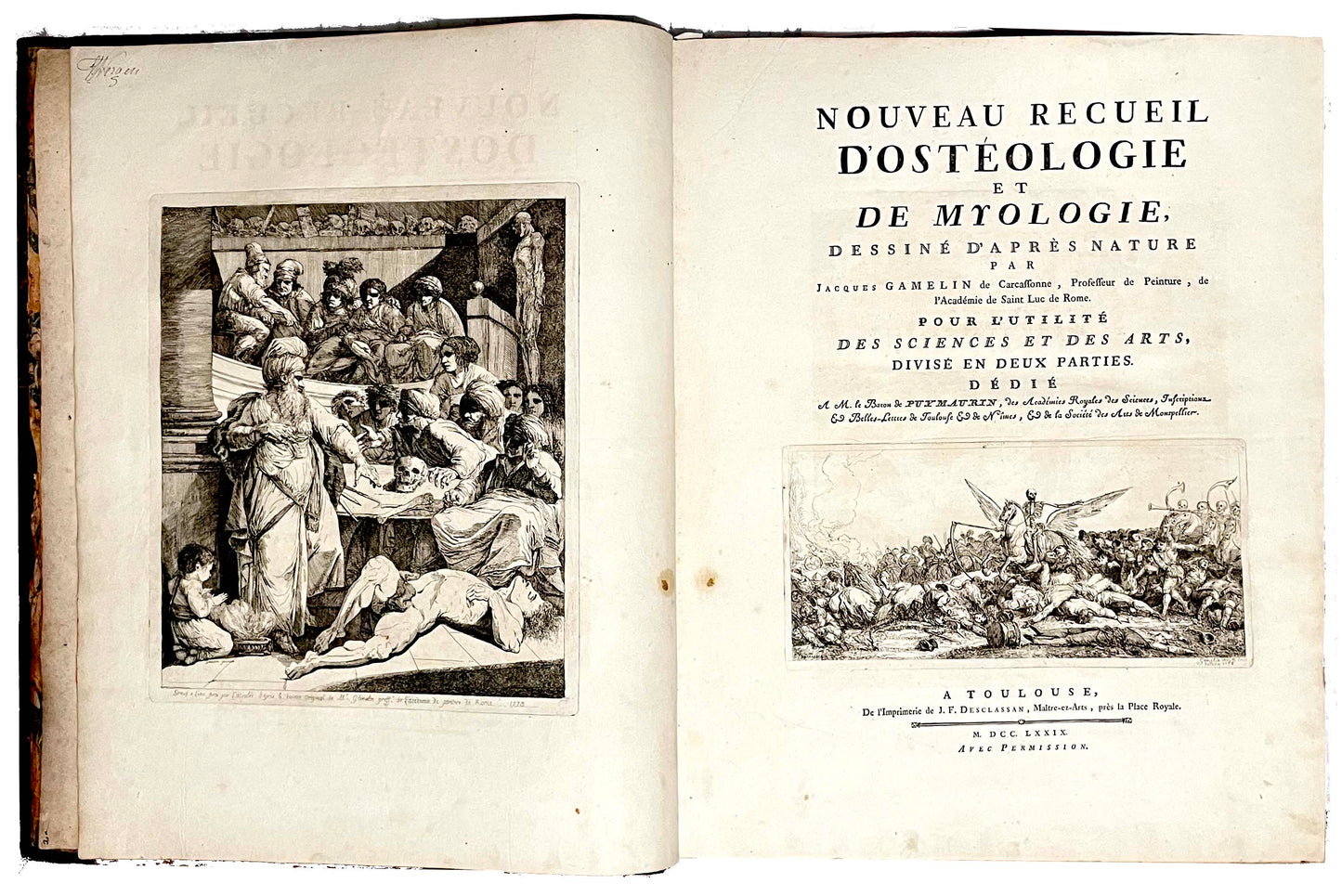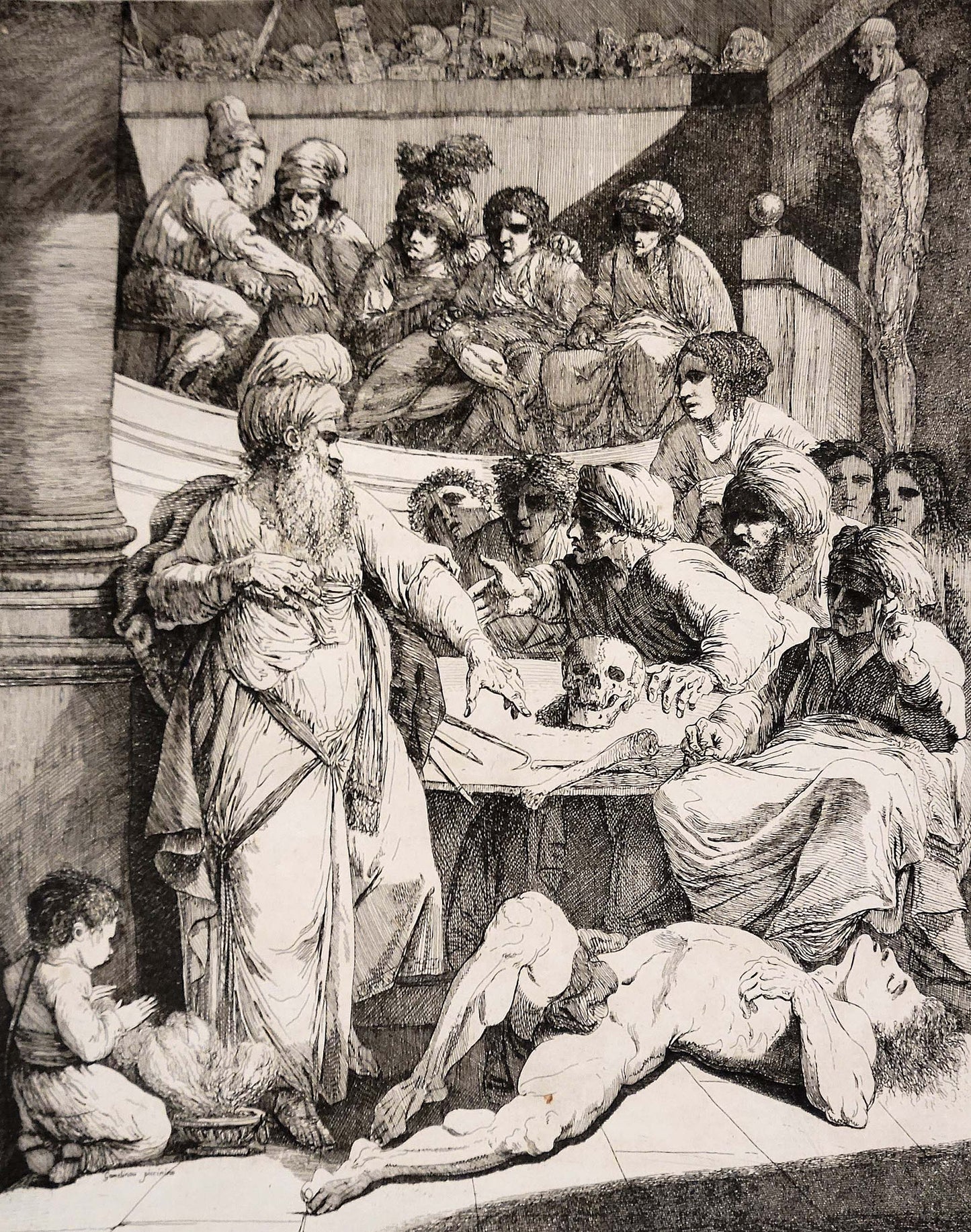Calab Rare Books
Jacques GAMELIN
Jacques GAMELIN
Couldn't load pickup availability
Share
Nouveau Recueil d'Ostéologie et de Myologie, dessiné d'après nature. Two parts in one volume. I: Full-page letterpress Prospectus, aquaforte frontispiece by Lavalée after Gamelin, title-page with apocalyptic etching by Gamelin, Dedication letter repeated in letterpress, Dedication portrait of Baron de Puymaurin engraved by Lavalée in crayon manner after Gamelin, followed by [24] ff. text, all versos blank. Illustrated with nine half-page etchings below text, and 41 full-page engraved plates, 11 in outline. II: Frontispiece engraved in crayon manner, title with small illustration in crayon manner signed by Gamelin, followed by [24] pp. of text with two versos blank, illustrated with 41 full-page plates. Total illustrations: 85 full-page engravings and/or lithographs and 11 half-page etchings or engravings. Folio, 525 x 410 mm, bound in contemporary French cat's paw calf, spine heavely gilt, maroon morocco spine label,. Toulouse: J.F. Desclassan, 1779.
First and Only Edition of this exceptional work, called a masterpiece of Romantic anatomical illustration. The artistic frontispiece based upon Salvator Rosa's academic anatomy lesson sets the tone for the entire volume, mixing artistic inspiration with technical anatomy of muscle and skeletal structure. The pièce de résistance is the full-page engraving of a kneeling skeleton reading a book.
Jacques Gamelin (1738- 1803), the son of a successful merchant from Carcassonne, entered the Art Académie Royale de Toulouse under the patronage of Baron de Puymaurin, a wealthy industrialist of Toulouse. Gamelin later went to Rome with Puymaurin's financial assistance to study under David and Vien and eventually became a painter to Pope Clement XIV. On the death of his father, which left Jacques a wealthy man, he returned to Toulouse where he undertook the prodigious work on his Nouveau receuil d'ostéologie et de myologie. With the assistance of local magistrates, Gamelin was given access to the corpses of executed criminals which he both dissected and made sketches of. He then hired two engravers to assist him in converting his drawings onto engraved plates. The project took several years to complete. Finally in 1779 Gamelin issued his book in 200 copies, offered for sale at 40 livres each. Sales were a disaster, bankrupting Gamelin in the process. Most of the unsold copies were either pulped or dismembered, accounting for the book's exceptional rarity.
There are a host of remarkable plates in the Nouveau Recueil, inter alia, on the first title an apocalyptic scene of Death on Winged Horse Riding over Fallen Bodies, followed by the Four Horsemen of the Apocalypse; later several osteological plates of skeletons engaged in very "undeath-like" pursuits, such as in playing musical instruments or bursting into a drunken tavern, or participating in a mock version of the rape of the Sabine women. Gamelin makes clear that his intention is to offer a work of value both to anatomy students and artists and draughtsmen. As with the tradition established by Vesalius, Gamelin meant to join both art and science in his great work.
"Gamelin is acknowledged as one of the 'little masters' of French eighteenth-century painting. The plates for his anatomical atlas, issued in an edition of only 200 copies, were prepared from drawings made at his own dissection facility; they are distinct from the plates of other works of its type, being larger, more artistically varied, and more expressive and fantastic in their conceptions.
Gamelin's plates show a constant interplay between the artistic and the anatomic. Gamelin's technical perfection, coupled with the emotional and fantastical elements in his images, have led him to be seen as a precursor of Goya; in fact, the young Goya may have known or studied with Gamelin, who taught in Rome during the time Goya was there" (Hook, Haskell F. Norman, p. 316).
An unwashed well margined copy in a contemporary binding rare thus, with the rare pre-publication Prospectus bound in. Binding with some professional restoration, some toning to a few leaves, however much less so then in most copies.
PROVENANCE: Mariano Gonz De Sepulveda with his bookplate on the front paste-down.
The Haskell F. Norman Library 872. Garrison-Morton 401.1. Choulant-Frank 352 (gives date 1799). Campbell Dodgson, "The Macabre in Two Centuries," in Print Collector's Quarterly XVI (April 1929), pp. 135-143. G. Bazin, "Un Précurseur de Goya et de Delacroix," Marianne, 17 August 1938, p. 8. Waller 3404. Rifkin & Ackerman, Human Anatomy, pp. 219-227.


















